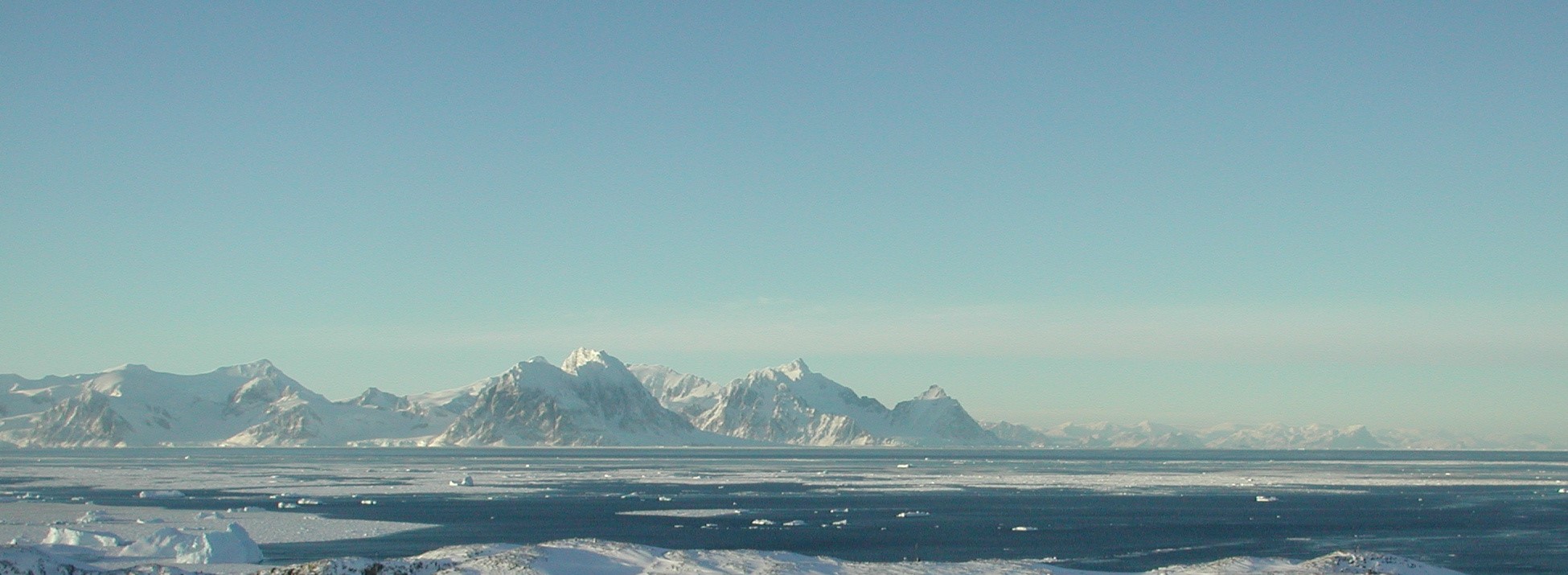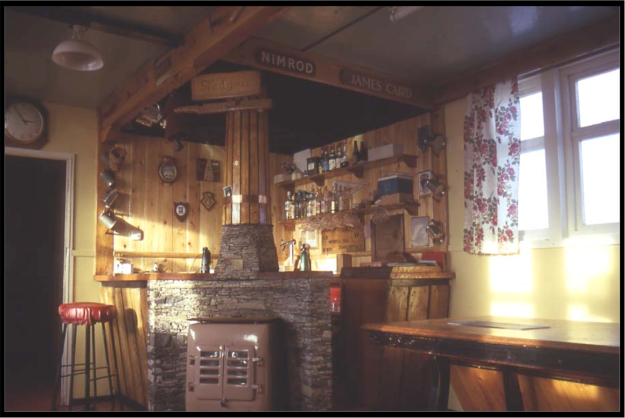Sledgers Bar 1974 (Photo: Chris Edwards)
The Sledgers Bar, Stonington Base E – Chris Edwards
When the base on Stonington Island was closed in late summer of 1975 an idea was mooted to have the stone fireplace incorporated into the new yet-to-be-built BAS Headquarters building, in Cambridge. The suggestion was that the fireplace could be a feature of a recreation or smoko room in the building. Of course at the time there were very few, if any, passenger/tourist vessels able or willing to penetrate into Marguerite Bay during the course of a voyage and thus the unofficial memorial to the two FIDS (Tom Allan, diesel mechanic and John Noel, radio operator) who built it would otherwise remain largely unrecognised.
These two Fids had constructed the stone fireplace, and, as relatively static base members they would not normally have constituted, other than on a temporary basis, a part of a sledging party. The fire surround, which had been built from many thousands of pieces of schist probably collected around the island, and must have taken many hours of work to give a symmetrical and pleasing shape to frame the Esse solid-fuel stove which formed the focus of base life. A small brass plaque on the chimney breast recognised the builders. Their graves lie under the cross at the western end of Stonington Island with a couple of engraved plaques. (See the account by Terry Tallis of the tragedy of their loss HERE ).
While almost everyone was on the summer field trip, having departed from base at the end of August 1974, Graham (Genghis) Wright (GA and BL), returned from the field early and, aided by Tony Gannon (builder), Steve (Boot) Wellington (DM), Paul Kirby (Radio Op) and others, together were tasked with shutting the base.
The Phase 1 of the new BAS Headquarters building (colloquially nicknamed “Fort Lego” on account of its use of uniform cast concrete external panels) off Madingley Road Cambridge, was formally opened in July 1976 by the Duke of Edinburgh. Incidentally if one visits the building today outside the main entrance there is a large rock with a medallion attached to it which incorrectly states that the building was opened (again by the Duke of Edinburgh) on 16 th June 1989 – this in fact refers to the addition to the original building, virtually tripling the size of the building and often regarded as the Falklands premium awarded to BAS by Margaret Thatcher after the war of 1982, when the annual BAS budget rocketed from around £5 million to around £15 million.
The various disciplines within the BAS hierarchy, which until that time had been distributed around the country in various institutions – Biological Sciences from Monks Wood, Huntingdon, Atmospheric and Upper Atmospheric Sciences from Swindon and Edinburgh, Earth Sciences from the University of Birmingham and the General Administration Office from London, via All Saints Passage, Cambridge, were all accommodated in the new building constructed round a quadrangle.
The fireplace from Stonington had been shipped back in a crate on Bransfield and while the
inevitable finishing touches were put to the building it remained exposed to the weather in an area to the west of the logistics and geological specimen store. While the intention may have been good the follow-up with the planners and administration must have been lacking as, in a later enquiry it transpired that it had been consigned to a skip.
The condition of Stonington in recent years shows a dramatic change in the living room of the base.

I wonder what happened to the large dining room table which had been liberated from the derelict Base St Martin at the Debenham Islands? (See Comments below, Geoff Cooper)



Sad to see the Sledgers Bar area in such a sorry state. I re-visited Stonington 3 times, twice to do maintenance work on the roof and once as staff on board Polar Pioneer.
The building had certainly deteriorated over the years.
Two years ago the Antarctic Heritage Trust did a major survey of the building and surrounds, including East Base, The party was on the island for several weeks and completed extensive restoration work, so I’d imagine a similar photo today the area would look quite tidy, except of course the missing bar – it was nothing short of vandalism the way BAS disposed of it in a skip.
Does anyone know what was intended of the half dozen tree trunk size logs on the east beach? Were they for a planned jetty?
Sorry, the above should read logs on the west beach.
There is still a large dining room table in the lounge to the immediate right of my photograph in front of the built-in bench – the very end of the table is visible underneath the grey blanket
There are no tree trunk size logs listed in the 1991 survey of Stonington by the US National Parks Service, and they listed everything from one M-2 light tank to the contents of the latrine.
Thanks Richard. I’ve got a photo of the logs somewhere, I’ll have to dig it out. they were close together and in a fairly neat pile, not simple drift wood. I certainly don’t remember them from ’73 (unless the beach had a good covering of snow) There was about 8 of them, 10 to 15ft in length, 12 to 15 inches diameter. I thought at the time they might have been put there with the idea of constructing a floating pontoon/jetty. They were just down from the BAS base, not by the American.
“… in a later enquiry it transpired that (the fireplace) had been consigned to a skip.”
Strikes me that this sums up very well the attitude that has developed at BAS to the pre Rothera era.
I was particularly struck by Dog Holden’s comments about the modern approach, after his return to Rothera in 2005 (“when the Summer Operations Manager (this may not be the precise job title), had just returned from a mid-season 2 weeks holiday in Spain”)!!
“Most of us visitors had also not appreciated that there was little, if any, sharing of the menial or communal tasks such as cooking, gash, cargo-shifting, drum-rolling, building etc. that were so much a part of our lives and contributed enormously to the team-spirit and shared experience, not to mention the social-levelling that went with such a life. Everyone now seemed to do only the job they had been hired for – contractors did most if not all the manual and trades work, not just the building mega-projects. (Nick Beer touched upon this in his piece reproduced in this website: “An Epilogue to Fids”.) Learning this, perhaps I should not have been surprised by the sight of a Fid on an exercise bike in a gym, in a busy summer season at Rothera. One thought of the exercise we used to all get just running a base.
I understand that present-day employees also do not particularly like being referred to as Fids? Thank goodness Steve (and all the contributors) have preserved some knowledge of what it once was to proudly be a Fid.
Regarding Dave’s query about the “tree trunk size logs” resting near the landing site on west beach below the BAS base, I can confirm that as of March 2018 there were indeed some large machined round timber sections still in-situ on the beach.However, unlike how Dave describes them above as “being 8 in number, 10-15ft long and in a neat pile” there remains only a few longer ones and some shorter sections of approx 3 to4ft long spread about.
When I arrived here in Jan18 they were covered in snow and by March when we were picked up they had ablated out.